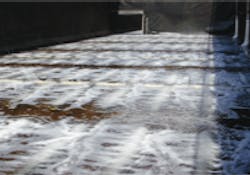Creating Cash
The City of Newark, Ohio, was seeking relief from excessive electric bills through significant updates. Its Licking River wastewater treatment plant (WWTP), on the east side of the city, completed installation of EDI FlexAir MiniPanel bubble diffusers in its three aeration basins, its WAS tanks and a post-aeration tank. The total project cost was $1,875,875, of which $370,630 went for the diffuser equipment and installation. Funding for the project included a gridSMART grant from AEP Ohio that could be used to cover energy-saving expenditures. A stipulation of the grant was that expenditures must show a seven-year return on investment, which only these diffusers could demonstrate. Newark’s new diffusers have not only improved critical plant processes, but also saved nearly $14,000 per month in electricity fees while creating excess capacity that allows more plant loading, including trucked waste streams that generate new revenues.
Background
The City of Newark is in the second phase of its Long Term Control Plan to optimize interactivity between its four plants and provide EPA-compliant, reliable service at reasonable rates. Priorities for this project were the replacement of 25-year-old existing equipment that was reaching the end of its service life, and the significant improvement of process efficiencies to reduce operating costs. Electricity powering the large, aging motors on the blowers that aerate the activated sludge was the WWTP’s greatest single operating expense.
Execution
An initial two-month study confirmed that the project was worth pursuing on a cost/benefit basis. This was followed by an engineering study to determine what the primary considerations should be for new equipment.
“We originally only intended to replace our two aging blowers with new, high-efficiency units,” said Darin Wise, the plant’s superintendent. “We hadn’t really thought it necessary to also replace the diffusers. But our research showed we could save more money in the long run by combining new, highly efficient diffusers with the new blowers. So we decided to do the whole project.”
Results
It was expected that the majority of electric savings would come from replacing the old blowers. What was not anticipated was the large amount of annual savings, and that pairing these new blowers with EDI FlexAir MiniPanel diffusers could actually generate new revenue streams.
“These EDI diffusers are just so much more efficient,” said Wise. “Putting air in the water has associated costs, and now our transfer efficiency and bubble efficiency is better. The MiniPanel diffuser creates more and smaller bubbles, which also rise slower in the tank to allow more contact time with bacteria. Our air requirements have dropped significantly—sometimes to a third of what they were.”
The unexpected boost in efficiency allowed 100% treatment to be accomplished in just two of three dedicated basins. This freed up the third basin to treat trucked-in industrial waste and septage, generating new disposal-fee revenues of $83,000 from January 1, 2014 to February 24, 2014. This third basin now represents pure profit, and the plant makes some margin on high-BOD/high-ammonia flows that require its efficient new aeration basin.
Wise is pleased with the savings and profit the new blower/EDI MiniPanel diffuser pairing is generating.
“We initially had to spend extra on electric to allow for more air use to treat additional loading, but our electric bill still dropped significantly, between $12,000 to $14,000 a month,” he said. “We’re installing another blower/diffuser combination now. We’ll depend on it as a redundant system.”
These improvements are projected to save $168,000 per year in electrical usage, and as of March 31, 2014, the plant had already taken in an extra $153,000 in loading fees for the year.
